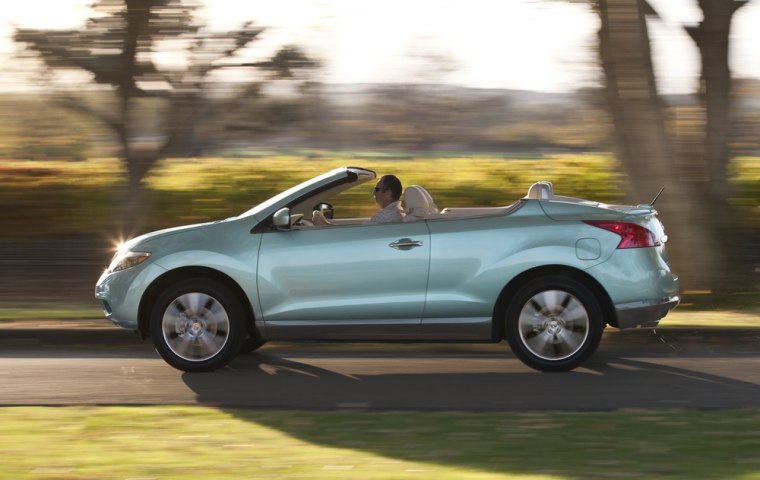Warm sunshine delivers a much-needed respite after a long, gray winter, and there’s no sensation more thrilling to many drivers than toggling a switch on a vehicle console and setting a chain of events into motion.
With a whir and a series of clicks and thumps the top of the new Nissan Murano CrossCabriolet lifts up, folds like canvas origami and tucks itself neatly away.
The CC, as it’s more commonly known, is one of the latest — and one of the more unusual — entries into the convertible market this year. It’s a segment that has seen some surprising innovations in recent years.
That may be critical to maintain demand, industry analysts say. There was a time when the convertible was one of the dominant automotive body styles, but in recent decades it has become little more than a minor niche. Some forecast a revival, but others warn that as fuel economy becomes ever more critical, many motorists will have to abandon the idea of driving “al fresco.”
Nissan’s CrossCabriolet has generated a fair bit of controversy. Some have called it a stroke of genius, while others are wondering whether it’s the answer to a question nobody has asked.
The original Murano five-door broke with tradition. Instead of trying to make the Murano look like a conventional SUV, Nissan opted for a decidedly curvaceous exterior. The CC gets a canvas top — indeed, it has the largest convertible roof on the market.
“We think there’s a small but viable market for a convertible like the CrossCabriolet,” especially in sun-challenged segments of the country like the Northeast, said Mike Drongowski, Nissan’s senior product planning manager.
Innovations like the hardtop convertible also have been aimed at building demand in regions where convertible sales traditionally have lagged behind the Sunbelt States. A hardtop design offers several advantages. Vehicles are quieter when a top is up and offer more protection against break-ins, among other things.
Demand for models like the BMW 3-Series and Infiniti G hardtop convertibles has generally exceeded expectations, but the hefty cost and extra space required to store a folding metal roof has convinced many carmakers to stay with traditional canvas designs instead.
The number of convertibles on the market has risen modestly in recent years, with new offerings like the Murano CrossCabriolet and the upcoming Fiat 500 convertible, among others, hitting showrooms.
Still, the recent growth in the number of convertible offerings is a far cry from the 1950s and '60s when a convertible option was the norm and nearly as common as coupe and wagon body styles.
Indeed, the ragtop nearly vanished by the late 1970s, in part due to tightened federal safety regulations for cars. But it wasn’t safety that nearly killed the convertible, notes automotive historian Jim Wren.
Instead, the culprit was poor sales.
The near-fatal blow to convertibles, Wren contends, came in the form of the interstate highway. After the establishment of the interstate network Americans began to drive faster, and as a result convertibles were no longer comfortable rides.
What’s more, by 1972 three-quarters of all cars sold in the U.S. came with factory air conditioning, rendering convertibles less desirable.
But it proved harder to keep the ragtop down, so to speak, than anyone might have imagined. Starting in the mid-1980s a few convertible offerings — starting with the Chrysler LeBaron — made a comeback.
Today, the ragtop redux is a small segment of the automotive market. Indeed, North American sales of convertibles peaked at just 247,519 units or 1.5 percent of total vehicle sales in 2005, according to research firm IHS, plunging to just 112,914 or 1 percent of sales in 2009.
The sharp decline outpaced the overall slump in the American new car market, with cash-strapped motorists resisting the added cost of purchasing a convertible option. Ford, for example, saw sales of its convertibles slip from nearly a quarter of Mustang sales in the mid-1990s to barely 13 percent of Mustang sales in the first quarter of 2011.
But now that the U.S. car market and the economy have started to recover there are signs of life in the struggling convertibles segment.
U.S. sales of convertibles rose more than 9 percent to 122,949 units last year, according to IHS, and the research firm forecasts demand for convertibles could nearly double to 223,224 by 2015 — a pace of growth that would outstrip the overall automotive recovery.
Or perhaps not, warns IHS analyst Aaron Bragman.
“The problem [with driving a convertible] is that when you have the top down, fuel economy drops,” he said. “That could become more critical as mileage becomes more important” to the average American motorist, Bragman added.
There’s no easy way to overcome the added aerodynamic drag of having the top down, Bragman said. It’s “why you don’t see any hybrid convertibles” and likely won’t see any battery-electric vehicles with convertible tops, he added.
But even with gasoline at $4 a gallon, the lure of the open air continues to beckon some. And car manufacturers will likely spotlight innovations like the hardtop convertible, which can improve aerodynamics when the top is up.
So while the convertible will never rebuild the demand it had in decades past, few expect it to vanish entirely.
